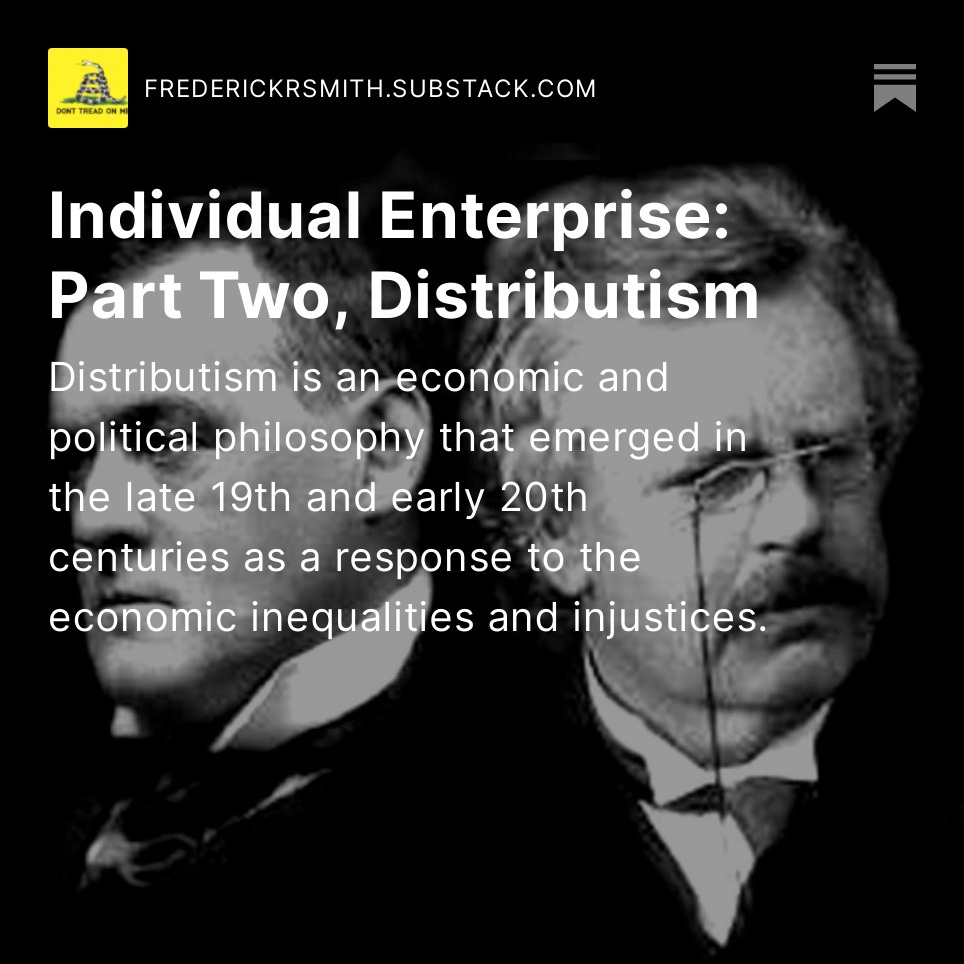Individual Enterprise: Part Two, Distributism
Distributism is an economic and political philosophy that emerged in the late 19th and early 20th centuries as a response to the economic inequalities and injustices.
The vast growth of the proletariat, the concentration of ownership into the hands of a few owners, and the exploitation by those owners of the mass of the community, had no fatal or necessary connection with the discovery of new and perpetually improving methods of production. The evil proceeded in direct historical sequence, proceeded patently and demonstrably, from the fact that England, the seed-plot of the Industrial System, was already captured by a wealthy oligarchy before the series of great discoveries began.
Hilaire Belloc, The Servile State
Foreword
Welcome to Individual Enterprise: Part Two, Distributism. I hope you enjoyed Part One, Traditional United States Philosophy. We traveled down memory lane of our founding history and how it made entrepreneurship possible. In part two, we will explore an alternative to the excesses of crony capitalism and socialism: Distributism.
Introduction
Distributism, also called Distributivism, is an economic and political philosophy. It developed in the late 19th and early 20th centuries to address perceived inequalities in capitalism and socialism. Joseph Hilaire Pierre René Belloc (1870-1953) and Gilbert Keith Chesterton (1874-1936) inspired distributionism to allow everyone to own property and have fair wealth. The Amish people embraced Distributism before Chesterton and Belloc. They understood and today utilize its concepts well.
Distributism
Distributism promotes fairness and happiness in society. It does this by advocating for property ownership for everyone. The philosophy suggests that society should allow many people to own productive things. These things include land, tools, and small businesses. People believe that spreading ownership gives power to individuals, families, and communities. This helps them feel independent and able to take care of themselves.
Distributism is critical of both capitalism and socialism. Critics criticize capitalism for concentrating wealth and power in the hands of a few. This leads to social inequality and the exploitation of labor. Distributionists argue that socialism centralizes economic control in the hands of the state. They believe this can stifle individual initiative and creativity.
One of the critical concepts in Distributism is the principle of subsidiarity. People and communities should make decisions at the local level to have more control. Subsidiarity supports the distributionist idea of limiting big corporations and government power. It promotes decentralized economic structures that focus on individuals and families.
Another central aspect of Distributism is the notion of the “just wage.” Distributionists think that workers should make enough money. That is, to support themselves and their families. They also believe in treating workers with dignity. This stands in contrast to the profit-maximization focus of capitalism, which can lead to exploitation and low wages.
In a Distributism-based economy, policies and mechanisms promote widespread property ownership. There are different ways to help people, like sharing ownership and giving them land. We can also encourage small businesses. Banks and other lenders could provide small businesses and people buying property better loan options.
Distributism differs from capitalism and socialism, but critics mention practical challenges. Skeptics question whether widespread property ownership is workable in a complex, modern economy. They say Distributism could become crony capitalism without strong rules, with inequalities still happening. Even so, Distributism is a good philosophy. It focuses on property ownership, economic justice, and decentralized decision-making. Thus, because of its key elements, Distributism is a self-policing economy:
Cooperative Ownership: Cooperative models of ownership, where workers collectively own and manage their workplaces, are often favored in Distributism. Cooperatives align with the philosophy’s goal of empowering individuals and ensuring a more equitable distribution of economic benefits.
Critique of Capitalism and Socialism: Distributism critiques both capitalism and socialism. It challenges capitalism’s potential to lead to wealth concentration and worker exploitation, as well as socialism’s centralization of economic control and potential suppression of individual initiative.
Decentralization and Subsidiarity: Distributism advocates for decision-making to occur at the most local level possible. This subsidiarity principle promotes autonomy and self-governance in economic and social affairs. It aims to avoid excessive centralization of power and encourages communities to have control over their economic activities.
Economic Fairness: Distributism focuses on achieving economic fairness by ensuring that individuals are paid fair wages for their work and that wealth is distributed equitably. A “just wage” is central, where workers receive compensation to live with dignity and support their families.
Environmental Sustainability: Some proponents of Distributism emphasize sustainable practices and environmental stewardship. They argue that decentralized, locally oriented economies are more likely to prioritize environmental protection.
Ethical and Moral Considerations: Rooted in classical Catholic social teaching, Distributism often incorporates ethical and moral considerations into economic decision-making. It prioritizes the common good, social solidarity, and the dignity of every person.
Human Flourishing: Distributism places a high value on the well-being and flourishing of individuals and communities. It sees economic arrangements as a means to support human dignity, self-sufficiency, and a balanced life.
Land Reform and Property Redistribution: Distributism may advocate for policies aimed at breaking up extensive land holdings and facilitating the distribution of property to more people. This aligns with the philosophy’s emphasis on property ownership as a means of empowerment.
Localism and Small-Scale Business: Distributism values local economies and small-scale businesses. It believes that these structures foster community engagement, diversity, and resilience, contrasting with the homogenizing tendencies of large corporations.
Widespread Property Ownership: At the heart of Distributism is the idea that productive property, such as land and tools, should be widely owned by individuals, families, and local communities. This ownership dispersal is believed to empower people and prevent the concentration of wealth and power in the hands of a few.
Distributism is not used as an entire economic system. Yet, its principles influence discussions on fairness, ownership, and decentralization. Financial models, policies, and worldwide movements reflect distributionist ideas differently. However, one particular group of people embraced the tenets of Distributism long ago.
The Wonderful Amish
I have interacted with Amish people for most of my life. Visiting Amish stores and purchasing their products is a rewarding experience. Spending an entire day with an Amish family taught me about Distributism, which their society embraced long before Belloc and Chesterton. It was an honor and life experience to “Break Bread” with that Amish family.
The Amish came from Switzerland and broke away from the Mennonites long ago. Their name comes from Jacob Amman, a Swiss bishop who led a movement for stricter discipline. In the 18th century, many Amish people came to North America for religious freedom. They settled in Lancaster County, Pennsylvania.
An unwavering Christian faith rooted in Anabaptist traditions is at the heart of their existence. This belief involves baptizing adults. It also means not avoiding challenges. Additionally, it means keeping religion free from government influence. To the Amish, faith isn’t mere “virtue signaling.” It is a humble, simple, communal way of life, a testament to their everyday actions.
Their distinctive and unadorned attire sets them apart from contemporary life. Men don broad-brimmed hats, suspenders, and plain, unassuming clothing. Women drape themselves in modest dresses and bonnets. These clothes show their dedication to being humble and not following cultural norms.
Their days unfold with simplicity and self-sufficiency at the forefront. Amish families work on farms using traditional tools and horse-drawn plows with dedication. They choose to live without modern technology, freeing them from modern complexities. Many autonomous communities refrain from using electricity, telephones, and automobiles.
The Amish society thrives because of their strong sense of community, not only in their homes and farms. They forge their bonds through a natural set of shared responsibilities. Amish lean on one another about farming, construction, and other communal tasks. On Sundays, they gather at their church for socializing and spiritual growth.
Education, too, follows a path steeped in tradition. Formal schooling extends only through the eighth grade. Children should help their families and community and protect their way of life. As testimony from personal experience, Amish are brilliant and humble people.
In their homes and communities, they speak a German dialect called Pennsylvania Dutch (Deitsch), which reminds them of the Old World. They turn to High German in religious services, preserving linguistic ties to their forebears.
Each Amish enclave crafts its unique “Ordnung,” a set of rules and guidelines that guide their daily existence. The local congregation determines these ordinances, distinct to each community.
Amish youth experience “Rumspringa” during their teenage years. This allows them to try the outside world and see modern life. As the story ends, they must embrace the Amish way of life or leave their caring community.
The Amish community is peaceful and doesn’t believe in violence. They refuse to join the military or take part in war.
Their communities recognize and celebrate their craftsmanship for its renowned meticulous quality. Many Amish engage in farming, furniture-making, quilting, and woodworking enterprises. Locals cherish these goods, made with tradition and dedication, and they attract tourists.
The Amish society symbolizes strong faith, simple living, and the power of tradition and community. Their cultural heritage remains alive and strong in certain United States and Canadian areas. It may seem isolated from mainstream society, but it still thrives.
The community of Amish people has a unique economic system connected to their religion, culture, and lifestyle. Here are some critical aspects of the Amish system that are akin to Distributism:
Agriculture: Farming is the cornerstone of the Amish economy. They typically rely on traditional farming methods, such as horse-drawn plows and hand tools, and avoid modern agricultural technology like tractors and chemical fertilizers. The focus is on sustainable and environmentally friendly farming practices.
Avoidance of Modern Technology: The Amish are known for rejecting most modern technology, including electricity and automobiles. This avoidance is rooted in their religious beliefs and has economic implications. Without modern machinery, they save on purchasing and maintaining such equipment expenses.
Barter and Local Currency: In some Amish communities, barter systems and local currencies are used for economic transactions. These systems foster self-reliance and limit reliance on external financial institutions.
Cooperative Spirit: Amish communities are interconnected and often collaborate on various economic activities. Barn raisings, for example, are community events where neighbors come together to build or repair a barn for one of their members. This sense of community and mutual support extends to economic endeavors as well.
Craftsmanship: Amish craftsmanship is renowned for its quality and craftsmanship. Many Amish families operate small businesses, such as woodworking shops or quilt-making studios, where they create handmade goods. These items are often sold both within their communities and to tourists, providing an essential source of income.
Limited Formal Education: The Amish generally provide formal education only up to the eighth grade, after which children are expected to contribute to the family’s economic activities. This practice supports the labor needs of their farms and businesses.
Localism: The Amish prioritized local economies and discouraged long-distance trade. They often sell their goods at local markets and to nearby non-Amish communities. This approach aligns with their commitment to community and self-sufficiency.
Simplicity and Minimalism: The Amish emphasize a simple and frugal lifestyle. They avoid extravagance and luxury, which helps to minimize their economic needs and allows them to focus on their religious and community priorities.
The Amish way of life elicits varied reactions. On one hand, their commitment to faith, family, and simplicity is admired by many. The Amish have low crime rates and strong community bonds. However, some criticize certain Amish practices, like puppy mills allegedly run by some members. While such criticism can sometimes cross into bigotry, a thoughtful critique that avoids broad generalizations can open productive dialogue. Any community has merits and downsides, and the Amish are no exception. Discussing them in a spirit of nuance and empathy rather than prejudice enables mutual understanding. Here is another shining example of what they are all about:
All of the above notwithstanding, naturally, big government despises the Amish. For example, the Leviathan has tentacles trained on a small-town Amish farmer in Virginia. He’s fighting back.
In a mournful tribute to the unwavering forgiveness and strength of the Amish, with tearful eyes, I invite you to read about the 2006 School Shooting in an Amish One-Room School.
Witness
And now, a few words about the 1985 fictional motion picture Witness.
A young Amish boy sees a murder at a train station in Philadelphia. They assign Detective John Book to keep him safe. Book must go into hiding in the boy’s Amish community to keep the boy safe. There, detached city cop Book struggles to adapt to the Amish’s slow, family-focused way of life. Yet, he soon finds himself drawn to the boy’s mother, Rachel (Kelly McGillis). Book must defend the peaceful community when the corrupt cops find him. The movie Witness is a thrilling story that compares city crime with Amish values. It also creates a surprising romance between Book and Rachel.
Using the train station depicted in the movie countless times and working on its infrastructure in the past gives me a unique perspective. Knowing the Amish, I can say that Witness exaggerates their lifestyle with Hollywood glamour. Even so, this essay’s ideas give film fans a new viewpoint. It also offers a unique perspective to first-time viewers. Enjoy!
Conclusion
In summary, Distributism fosters the spreading of economic power and property ownership. It sees this as a better option than crony capitalism or socialism. It aims to empower small producers, workers, and communities rather than big businesses.
The Amish have a bountiful economic system akin to Distributism. It reflects their commitment to simplicity, self-sufficiency, and community. The way they farm, their skillful work, their refusal of modern technology, and their working together help their lifestyle. Amish food is awesome and wholesome. Sign me up, Scotty!
Afterword
The Amish are famous for their skill in making furniture and buildings. They are also great farmers and cooks. Yet, there is another viewpoint to think about. The Amish system cannot make steel in quantity. Therefore, they are unable to manufacture cars. Amish don’t use them anyway. In cases where necessary, they travel on public transportation only made possible with steel. Despite avoiding modern medicine, the Amish resort to hospitals only in dire emergencies. They also reject traditional vaccines and other “lethal injections.” Thus, the Amish weathered the COVID-1984 psychological operations (psy-ops) virtually unscathed.
Analyzing various subjects, to be honest, we must recognize downsides. The neo-con involvement in Central America in the 1980s and ongoing COVID-1984 psy-ops are two examples of many instances of corruption under crony capitalism. It is a metastasized capitalism and has grown enormously, almost like fascism. It’s important to note that select people become ultra-rich through crony capitalism like Bill Gates. Many of these elitists exhibit psychopathic traits, revealing their authentic selves and concealed motives.
I am aware that some may perceive Distributism as a variant of communism, but this is a misconception. Distributism is a belief system that aligns with traditional Catholic teachings. Intellectuals, including past Church leaders, who oppose socialism and communism, support Distributism. Critics connect distributism to traditional Catholicism, leading to prejudicial criticism. Yet, Distributism is good because it promotes property ownership.
The Amish participate in capitalism by selling their products to anyone who wants them. Thus, it is time to take a realist approach. If I had a magic wand, all forms of collectivism would vanish.1 Instead, we would have a government as initially prescribed by the Constitution coupled with Traditional United States Philosophy and a touch of Distributism.📕
Sources
Distributism
Fredericks R. Smith’s teen years raking, shoveling, and cutting
Amish
Frederick R. Smith’s encounters and interactions with Amish people
I warmly encourage you to consider becoming a paid subscriber if you have the means. Regardless of your choice, your support is deeply appreciated. From the bottom of my heart, thank you for your invaluable support!
Socialism, communism, fascism, and feudalism








https://open.substack.com/pub/dailynewsfromaolf/p/amish-officially-declared-worlds
https://open.substack.com/pub/christophermessina/p/pennsylvania-taxpayers-foot-the-bill